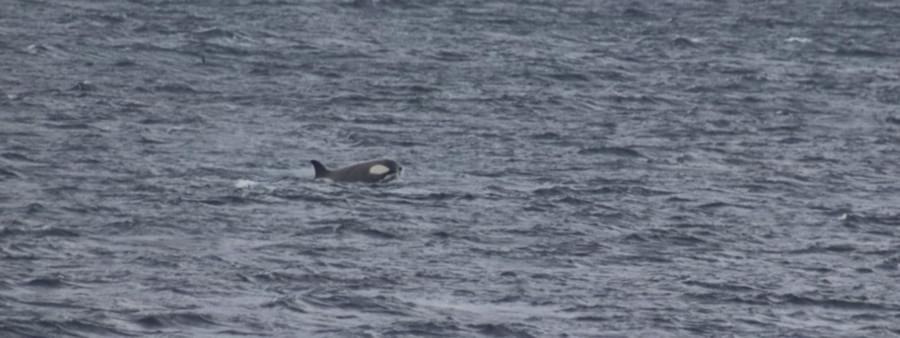Hebrides Ocean Conservationist Jess tells us all about the orcas (also known as killer whales) that have been making waves on the West coast of Scotland this spring.
When passengers on the CalMac Ferry network see me out on deck wearing the ORCA logo on my jacket, they often ask me with excitement, what the likelihood is of seeing orcas. These animals have captured human imagination for hundreds of years. Everyone I speak to has heard of them, and everyone wants to see them.
Orcas, also known as killer whales, are the largest species of dolphin in the world. They can reach approximately ten meters long and their bold black and white patterning makes them unmistakable as they rise and sink from the ocean surface.
The name ‘killer whale’ is thought to be from years ago when fishermen referred to the orcas as ‘whale killers’ or ‘killers of whales’ as they witnessed them hunt whale species, and so over time the name evolved into killer whales. Their large size probably contributed to people thinking they were whales, but they are in fact great big dolphins!
There is something quite scary about killer whales; their sheer size, their efficient and brutal hunting abilities, and their white eye patches that slowly appear in murky water can be chilling. When watching footage of them hunting cute round eyed seals, we naturally put ourselves in the shoes (well… flippers) of the seals that are more relatable and equal to our size, and we imagine ourselves being hunted, making them all the more frightening.
I was extremely lucky to see orcas in Antarctica where I was surveying marine mammals for ORCA and Hurtigruten Expeditions. Here they are famous for swimming in unison to wash seals from their safe ice float, demonstrating amazing cooperation and planning abilities. In Antarctica, the famous polar explorers that were part of Ernest Shackleton’s attempt to reach the South Pole wrote of the killer whales in their diaries, referring to them as monsters whose presence left them feeling uneasy.

But despite being a bit scary, orcas are loved by people, and they are often at the top of wildlife-watching wish lists. The 1993 feature film Free Willy had a real impact on the orcas’ public relations, depicting them as caring and intelligent creatures capable of forming bonds and showing emotions. And they are! Orcas have fascinating social structures and live in tight-knit family pods of multiple generations and their intellectual abilities are amazing.
Orcas are found in all the world’s oceans, and for well over 30 years, glimpses of jet-black towering dorsal fins rising from the Hebridean seas have been reported from the Isle of Mull to Lewis. This spring, there have been lots of reported sightings of two individual orcas named John Coe and Aquarius in and around the Hebrides, and they are a hot topic! John Coe is said to be the ‘Holy Grail’ of UK whale watching. He has a distinctive notch missing from the back of his huge (almost 2m) dorsal fin and is very recognizable, and there is a very active community of whale enthusiasts in Scotland keeping an eye out for him and his companion.
These two celebrities are usually seen in the Hebrides but have a big range and are seen fairly regularly from the West coast of Ireland too. During the lockdowns of 2020 the two of them travelled all the way down to Cornwall and Dover and back again in a matter of days. This was the first time orcas were recorded on the South coast of England.
Although it is an ambition of mine to see these famous cetaceans in Scotland, I imagine the sight would come with both excitement and yet some sadness. John Coe and Aquarius were once part of a much larger pod living on the west coast, known as the West Coast Community.
Although currently, all killer whales worldwide are thought to be the same species, there is a variety of ecotypes within the world population. Different communities of killer whales around the world have different appearances, food sources, hunting strategies, behaviours, and even cultures. John Coe and Aquarius are from an ecotype group called the Eastern North Atlantic Type 2 killer whales.
They are an isolated group that has never been recorded interacting with any other groups. In the 1980s, there were thought to be around 20 individuals in the West Coast Community. In the 1990’s this number went down to 14. This group hasn’t produced any calves for thirty years, and since 2016, no individuals have been seen apart from John Coe and Aquarius. Sadly, it is strongly suspected that all the others have died, and John Coe and Aquarius are the only two surviving orcas from the Eastern North Atlantic Type 2 group. It is thought that an accumulation of very high levels of chemical pollutants called PCBs in their bodies consumed through their food chain, combined with a low genetic diversity in the group, has led to their downfall. As John Coe and Aquarius age, a heartbreaking story of extinction is looming over the West Coast Community of orcas.
Seeing either of these two orcas in Scotland would be a huge privilege and a memorable moment indeed. Although it is incredibly sad, their story gives us the opportunity to inform people about how precious life in our oceans is and teach them about marine conservation issues such as chemical pollution. The more we know about how our actions can impact the oceans, the more steps we can take to safeguard our spectacular marine life and prevent stories like the West Coast Community’s from happening again.
I shall be keeping my eyes firmly open on the CalMac Ferries network this summer in the hope of catching a glimpse of these amazing, scary, beautiful, and precious beasts.

